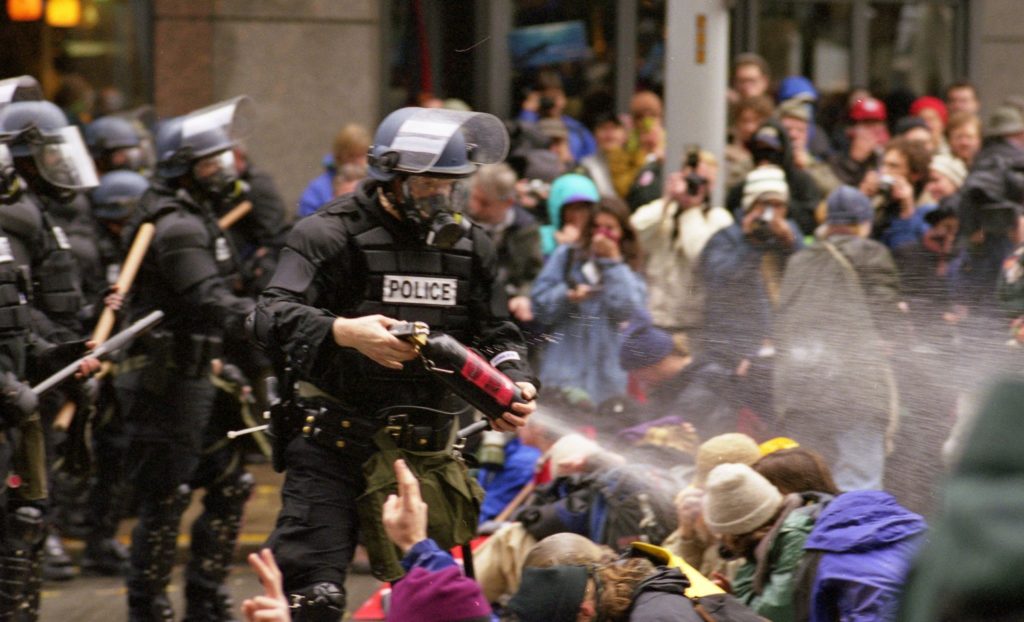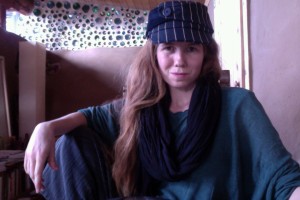
On November 30th, 1999, the World Trade Organization was scheduled to conduct a summit in Seattle, WA. Due to the intervention of activists, the meetings took place amidst widespread resistance, protest, and disruption. Although the acts of property damage, violence, and the violent repression tactics of the police were widely publicized, a number of on-the-ground nonviolent activists urge us to question the narrative of violence, and dig deeper into the nonviolent side of the story.
Organizer David Solnit wrote, “It was a moment when organized resistance became a genuine popular uprising, successfully shutting down the opening day of the WTO meeting, taking over the downtown core of a major American city, and contributing to the collapse of negotiations that would have increased poverty, destruction, and misery around the world.”
He goes on to describe how the 40,000 demonstrators transformed the streets “into a festival of resistance. Tens of thousands of people joined the nonviolent direct action blockade that encircled the WTO conference site, keeping the most powerful institution on earth shut down from dawn until dusk. … Long shore workers shut down every West Coast port from Alaska to Los Angeles. Large numbers of Seattle taxi drivers went on strike. All week the firefighters union refused authorities’ requests to turn their fire hoses on people. Tens of thousands of working people and students skipped or walked out of work or school.”
Seattle mayor Paul Schell declared a state of emergency, imposed a curfew, and created a 50-block “no-protest zone”. The tactics of the Seattle Chief of Police Norm Stamper became the basis of the “Seattle Model” of repressing large demonstrations. In later interviews, Norm Stamper cites this as being highly unfortunate. He ultimately expressed regret about how he handled the protests in Seattle. During the Occupy protests in 2011, he publicly stated the need to create an alternative to what he termed “the paramilitary bureaucracy that is American policing”. He also said that no change would happen “unless, even as we cull ‘bad apples’ from our police forces, we recognize that the barrel itself is rotten”.
Ken Butigan was also an on-the-ground participant at the Battle of Seattle. In his book, Nonviolent Lives, he describes how he was part of a peace team that worked to maintain nonviolent discipline and recounts a series of challenging encounters as acts of property damage broke out. He maintains that the nonviolent actions were what led to the most effective achievements of the anti-globalization movement.
He writes, “To me there was a better way than property destruction to achieve this goal—and the people marching that week in Seattle were illustrating it. Gathered from around the planet, they were dramatizing a growing movement for change using nonviolent people power. These thousands were alerting and educating the public in a way, from my perspective, that violent action would not. Violent action will not panic the power-holders but it will push away the general populace. Power-holders, in fact, love it, because it gives them an excuse to delegitimize and destroy movements. In the end, social change depends not on creating the sense of chaos and social disorder, but on mobilizing the populace to remove its support for such injustice and to exercise people-power for change.”
A number of organizers and activists have analyzed the Battle of Seattle for strengths, weaknesses, and lessons to learn. George Lakey’s “Mass Action Since Seattle” identified seven ways to improve our nonviolent campaigns:
1. Create more “dilemma demonstrations,” placing the powers that be in the awkward position of either allowing the demo to succeed or exposing their own moral bankruptcy by attacking a peaceful protest. Do not give cameras images of police as protectors of the peace.
2. Decide specifically who you are trying to influence (e.g., policymakers or general public); it’s not always possible to do everything.
3. Use campaigns more often; become proactive rather than reactive.
4. Understand the role of mass media. “We free up our creative energy when we simply acknowledge that these biases exist, rather than go into righteous indignation every time we read or see a new piece that puts us in an unfavorable light.”
5. Heighten the contrast between protesters and police behavior; “using appropriate symbolism so that the part of the public we most want to influence will see us as the people standing for justice.”
6. Take a powerful attitude toward the prospect of state repression. Use it rather than waiting for it to use you. Closing a group to avoid infiltration is often worse than maintaining the high ground and staying open to new people and ideas.
7. Fully and explicitly commit to strategic nonviolent action. Clearly outline a position on violence, especially when working in coalition with people who risk parole violation.
The Battle of Seattle managed to shut down negotiations, ignite a series of global actions to halt massive, destructive trade deals, and shift the national discourse around globalization. Similar to how Occupy inserted the concept of inequality into public consciousness, the Battle of Seattle is often cited as bringing the idea of “anti-globalization” into the US media. Knowing our history, learning from the successes, and studying the failures or mistakes, is one way to build the culture of active nonviolence. We gain skills, insights, wisdom, strategy, and creativity by examining the campaigns of the past, including the Battle of Seattle.
Learn more here: https://nvdatabase.swarthmore.edu/content/activists-prevent-world-trade-organization-conference-seattle-1999
Photo Credit: By Steve Kaiser from Seattle, US – WTO protests 10, CC BY-SA 2.0, https://commons.wikimedia.org/w/index.php?curid=4994979
This article is from Rivera Sun’s book of nonviolent histories that have made our world. Click here for more information.
______________________________________

Rivera Sun is a change-maker, a cultural creative, a protest novelist, and an advocate for nonviolence and social justice. She’s a love-based revolutionary and the author of The Dandelion Insurrection, The Way Between and ten other fiction, non-fiction and poetry books. Her essays and writings are syndicated by Peace Voice, and have appeared in over a hundred journals nationwide. Rivera Sun speaks and facilitates workshops in strategy for nonviolent change across the country and around the world. She connects the dots between the issues, shares solutionary ideas, and inspires people to step up to the challenge of being a part of the story of change in our times. www.riverasun.com